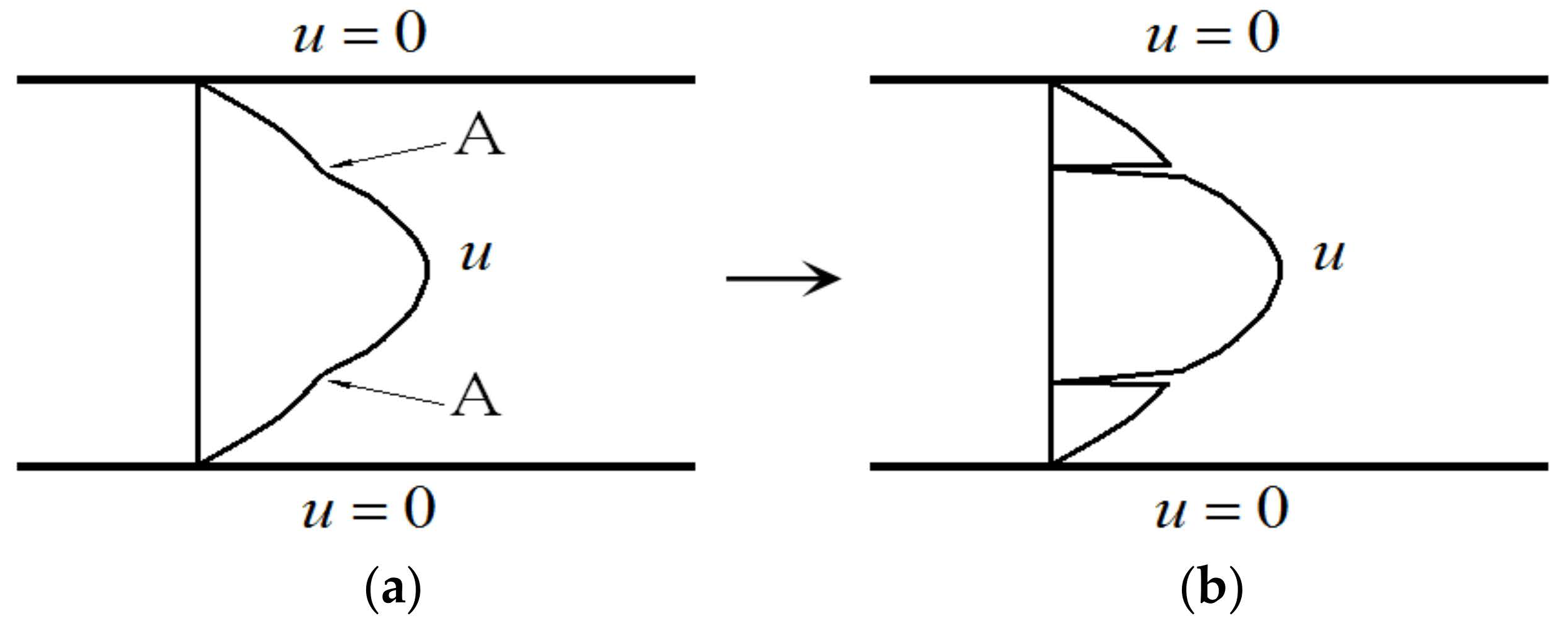No Existence and Smoothness of Solution of the Navier-Stokes Equation
Abstract
:1. Introduction
2. Stability and Turbulent Transition of Plane Poiseuille Flow
3. Navier-Stokes Equation in Form of Poisson Equation
3.1. Navier-Stokes Equation: Poisson Equation
3.2. Reduced Form of Navier-Stokes Equation: Laplace Equation
3.3. Solution of Navier-Stokes Equation for Steady Laminar Flow
4. Solution of Navier-Stokes Equation for Transitional and Turbulent Flows
4.1. Strategy to Solve the Problem
4.2. Finding the Singular Point on the Velocity Profile
4.3. Solution with Variation of Source Term
5. Significance of the Singularity in Turbulence
6. Conclusions
Funding
Institutional Review Board Statement
Informed Consent Statement
Data Availability Statement
Conflicts of Interest
References
- Foias, C.; Manley, O.; Rosa, R.; Temam, R. Navier-Stokes Equations and Turbulence; Cambridge University Press: Cambridge, UK, 2004. [Google Scholar]
- Fefferman, C.L. Existence and Smoothness of the Navier-Stokes Equation; Clay Mathematics Institute: Peterborough, NH, USA, 2000; pp. 1–6. Available online: http://www.claymath.org/sites/default/files/navierstokes.pdf (accessed on 23 February 2022).
- Leray, J. Sur le mouvement d’un liquide visquex emplissent l’espace. Acta Math. J. 1934, 63, 193–248. [Google Scholar] [CrossRef]
- Dou, H.-S. Energy gradient theory of hydrodynamic instability. In Proceedings of the Third International Conference on Nonlinear Science, Singapore, 30 June–2 July 2004; Available online: https://www.researchgate.net/publication/2147222 (accessed on 23 February 2022).
- Dou, H.-S. Mechanism of flow instability and transition to turbulence. Inter.J. Non-Linear Mech. 2006, 41, 512–517. Available online: https://www.researchgate.net/publication/245215903 (accessed on 23 February 2022). [CrossRef]
- Dou, H.-S. Physics of flow instability and turbulent transition in shear flows. Inter. J. Phys. Sci. 2011, 6, 1411–1425. Available online: https://www.researchgate.net/publication/2176288 (accessed on 23 February 2022).
- Dou, H.-S.; Khoo, B.C. Investigation of turbulent transition in plane Couette flows using energy gradient method. Advances in Appl.Math. and Mech. 2011, 3, 165–180. Available online: https://www.researchgate.net/publication/2147221 (accessed on 23 February 2022). [CrossRef] [Green Version]
- Dou, H.-S.; Khoo, B.C.; Yeo, K.S. Instability of Taylor-Couette Flow between Concentric Rotating Cylinders. Inter. J. Thermal.Sci. 2008, 47, 1422–1435. Available online: https://www.researchgate.net/publication/222709642 (accessed on 23 February 2022). [CrossRef] [Green Version]
- Dou, H.-S. Singularity of Navier-Stokes equations leading to turbulence, Advances in Applied Mathematics and Mechanics. arXiv Prepr. 2021, 13, 527–553. Available online: https://www.researchgate.net/publication/325464212 (accessed on 23 February 2022).
- Beale, J.T.; Kato, T.; Majda, A.J. Remarks on the breakdown of smooth solutions for the 3D Euler equations. Commun. Math. Phys. 1984, 94, 61–66. [Google Scholar] [CrossRef]
- Yao, J.; Hussain, F. On singularity formation via viscous vortex reconnection. J. Fluid Mech. 2020, 888, R2. [Google Scholar] [CrossRef]
- Moffatt, H.K.; Kimura, Y. Towards a finite-time singularity of the Navier-Stokes equations. Part 2. Vortex reconnection and singularity evasion. J. Fluid Mech. 2019, 870, R1. [Google Scholar] [CrossRef] [Green Version]
- Moffatt, H.K. Singularities in fluid mechanics. Phys. Rev. Fluids 2019, 4, 110502. [Google Scholar] [CrossRef] [Green Version]
- Schlichting, H. Boundary Layer Theory, 7th Ed. ed; Springer: Berlin, Germany, 1979. [Google Scholar]
- Nishioka, M.; Iida, S.; Ichikawa, Y. An experimental investigation of the stability of plane Poiseuille flow. J. Fluid Mech. 1975, 72, 731–751. [Google Scholar] [CrossRef]
- Biringen, S. Final stages of transition to turbulence in plane channel flow. J. Fluid Mech. 1984, 148, 413–442. [Google Scholar] [CrossRef]
- Sandham, N.D.; Kleiser, L. The late stages of transition to turbulence in channel flow. J. Fluid Mech. 1992, 245, 319–348. [Google Scholar] [CrossRef]
- Luo, J.; Wang, X.; Zhou, H. Inherent mechanism of breakdown in laminar-turbulent transition of plane channel flows, Science in China Ser. G Physics. Mech. Astron. 2005, 48, 228–236. [Google Scholar] [CrossRef]
- Luchikt, T.S.; Tiederman, W.G. Timescale and structure of ejections and bursts in turbulent channel flows. J. Fluid Mech. 1987, 174, 524–552. [Google Scholar]
- Alfredsson, P.H.; Johansson, A.V. On the detection of turbulence-generating events. J. Fluid Mech. 1984, 139, 325–345. [Google Scholar] [CrossRef]
- Schlatter, P.; Stolz, S.; Kleiser, L. Large-eddy simulation of spatial transition in plane channel flow. J. Turbul. 2006, 7, N33. [Google Scholar] [CrossRef]
- Nishioka, M.; Asai, M.; Iida, S. Wall phenomena in the final stage of transition to turbulence. In Transition and Turbulence; Meyer, R.E., Ed.; Academic Press: New York, NY, USA, 1981; pp. 113–126. [Google Scholar]
- Kim, J.; Moin, P.; Moser, R.D. Turbulence statistics in fully developed channel flow at low Reynolds number. J. Fluid Mech. 1987, 177, 133–166. [Google Scholar] [CrossRef] [Green Version]
- Johansson, A.V.; Her, J.-Y.; Haritonidis, J. On the generation of high-amplitude wall-pressure peaks in turbulent boundary layers and spots. J. Fluid Mech. 1987, 175, 119–142. [Google Scholar] [CrossRef]
- Bernard, P.S.; Thomas, J.M.; Handler, R.A. Vortex dynamics and the production of Reynolds stress. J. Fluid Mech. 1993, 253, 385–419. [Google Scholar] [CrossRef] [Green Version]
- Ghaemi, S.; Scarano, F. Turbulent structure of high-amplitude pressure peaks within the turbulent boundary layer. J. Fluid Mech. 2013, 735, 381–426. [Google Scholar] [CrossRef] [Green Version]
- Swearingen, J.D.; Blackwelder, R.F.; Spalart, P.R. Inflectional instabilities in the wall region of bounded turbulent shear flows. In Proceedings of the Summer Program; Center for Turbulence Research, Stanford Univercity: Stanford, CA, USA, 1987; pp. 291–295. [Google Scholar]
- Fletcher, C.A.J. Computational Techniques for Fluid Dynamics; Springer: Berlin, Germany, 1991; Volume 1. [Google Scholar]





Publisher’s Note: MDPI stays neutral with regard to jurisdictional claims in published maps and institutional affiliations. |
© 2022 by the author. Licensee MDPI, Basel, Switzerland. This article is an open access article distributed under the terms and conditions of the Creative Commons Attribution (CC BY) license (https://creativecommons.org/licenses/by/4.0/).
Share and Cite
Dou, H.-S. No Existence and Smoothness of Solution of the Navier-Stokes Equation. Entropy 2022, 24, 339. https://doi.org/10.3390/e24030339
Dou H-S. No Existence and Smoothness of Solution of the Navier-Stokes Equation. Entropy. 2022; 24(3):339. https://doi.org/10.3390/e24030339
Chicago/Turabian StyleDou, Hua-Shu. 2022. "No Existence and Smoothness of Solution of the Navier-Stokes Equation" Entropy 24, no. 3: 339. https://doi.org/10.3390/e24030339




